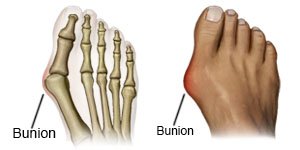Bunion
Medically reviewed by Drugs.com. Last updated on Aug 4, 2025.
A bunion is a bony lump at the base of your big toe. As it grows, it sticks out from the side of your foot and may move your toe out of place.
 |
DISCHARGE INSTRUCTIONS:
Return to the emergency department if:
- You have severe pain in your toe.
- You cannot put weight on your foot.
Call your doctor if:
- You cannot do your daily activities because of the pain.
- You have questions or concerns about your condition or care.
Medicines:
You may need any of the following:
- Acetaminophen decreases pain and fever. It is available without a doctor's order. Ask how much to take and how often to take it. Follow directions. Read the labels of all other medicines you are using to see if they also contain acetaminophen, or ask your doctor or pharmacist. Acetaminophen can cause liver damage if not taken correctly.
- NSAIDs , such as ibuprofen, help decrease swelling, pain, and fever. This medicine is available with or without a doctor's order. NSAIDs can cause stomach bleeding or kidney problems in certain people. If you take blood thinner medicine, always ask your healthcare provider if NSAIDs are safe for you. Always read the medicine label and follow directions.
- Take your medicine as directed. Contact your healthcare provider if you think your medicine is not helping or if you have side effects. Tell your provider if you are allergic to any medicine. Keep a list of the medicines, vitamins, and herbs you take. Include the amounts, and when and why you take them. Bring the list or the pill bottles to follow-up visits. Carry your medicine list with you in case of an emergency.
Self-care:
- Use a bunion pad. Wear a thick, ring-shaped pad around and over the bunion to cushion it.
- Wear shoes that fit well. Wear wide, low-heeled shoes that have plenty of room for your toes. Do not wear tight shoes or heels that are higher than 2 inches.
- Wear shoe inserts or arch supports. These will decrease pressure on the bunion.
- Separate your big toe at night. Separate the big toe from the others with a foam pad while you sleep. Use a light elastic bandage to keep the pad in place.
- Stretch your foot each day. This will help decrease pressure and increase foot strength. Ask what foot exercises are best for you.
- Apply ice on your toe for 15 to 20 minutes every hour or as directed. Use an ice pack or put crushed ice in a plastic bag. Cover it with a towel. Ice helps prevent tissue damage and decreases swelling and pain.
- Go to physical therapy if directed. A physical therapist teaches you exercises to help improve movement and strength, and to decrease pain.
Follow up with your doctor as directed:
You may be referred to a podiatrist (foot specialist). Write down your questions so you remember to ask them during your visits.
© Copyright Merative 2025 Information is for End User's use only and may not be sold, redistributed or otherwise used for commercial purposes.
The above information is an educational aid only. It is not intended as medical advice for individual conditions or treatments. Talk to your doctor, nurse or pharmacist before following any medical regimen to see if it is safe and effective for you.
Further information
Always consult your healthcare provider to ensure the information displayed on this page applies to your personal circumstances.
